A Multilingual Instructional Intervention to Promote Academic English Proficiency
Brief Description
This project proposes to build the heritage language, or native language, skills of speakers of a less-commonly-taught language: Bengali. Bangladeshi Americans belong to one of the fastest growing ethnic groups in New York City. In 2013, there were 440 students from Bangladesh attending LaGuardia Community College, making up 2.7% of the total student body, and in 2011, 11.5% of our English as a Second Language (ESL) students were Bengali speakers. A vast majority, however, struggles with the dual challenge of acquiring literacy skills as they develop proficiency in English. Our project, the first of its kind at LaGuardia, will implement a multilingual instructional intervention with a sample of Bengali-speaking students. If successful, this intervention can be replicated economically with other language groups, using an array of instructional staff, tutors, and academic supports to provide the L1 components. This project will also help to retain students at LaGuardia Community College. Unfortunately many students begin taking ESL, but if they fail their courses and must repeat a class multiple times, they are likely to drop out. Students who succeed in our ESL courses go on to succeed at LaGuardia and raise graduation rates.
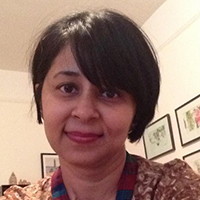 Dr. Ruhma Choudhury is an Assistant Professor in the Department of Education and Language Acquisition at LaGuardia Community College, CUNY. Her doctorate in Teaching English to Speakers of Other Languages (TESOL) is from Teachers College, Columbia University. She received her MA in English Literature from Dhaka University, Bangladesh and MA in TESOL from California State University, Hayward. She has taught a range of courses, including ESL, EFL, academic writing, linguistics, teaching methodology, and writing. Her research interests include language policy, teacher education, and critical approaches to language learning. Her most recent publication, “Raising Bilingual and Bicultural Bangladeshi-American Children in New York City: Perspectives from Educators and parents in a Bengali Community Program,” appeared in Bilingual Community Education and Multilingualism – Beyond Heritage Languages in a Global City (2012), co-edited by Ofelia Garcia, Zeena Zakahria, and Bahar Otcu.
Dr. Ruhma Choudhury is an Assistant Professor in the Department of Education and Language Acquisition at LaGuardia Community College, CUNY. Her doctorate in Teaching English to Speakers of Other Languages (TESOL) is from Teachers College, Columbia University. She received her MA in English Literature from Dhaka University, Bangladesh and MA in TESOL from California State University, Hayward. She has taught a range of courses, including ESL, EFL, academic writing, linguistics, teaching methodology, and writing. Her research interests include language policy, teacher education, and critical approaches to language learning. Her most recent publication, “Raising Bilingual and Bicultural Bangladeshi-American Children in New York City: Perspectives from Educators and parents in a Bengali Community Program,” appeared in Bilingual Community Education and Multilingualism – Beyond Heritage Languages in a Global City (2012), co-edited by Ofelia Garcia, Zeena Zakahria, and Bahar Otcu.
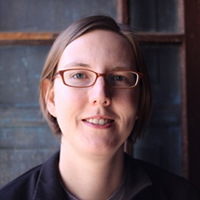 Leigh Garrison-Fletcher is an Assistant Professor of ESL and Linguistics in the Department of Education and Language Acquisition at LaGuardia Community College, the City University of New York. She received her PhD in Linguistics from the Graduate Center, the City University of New York, where she focused on second language acquisition. Her research interests include the role of the native language in second language learning, the acquisition of second language literacy, and the assessment of bilingual students.
Leigh Garrison-Fletcher is an Assistant Professor of ESL and Linguistics in the Department of Education and Language Acquisition at LaGuardia Community College, the City University of New York. She received her PhD in Linguistics from the Graduate Center, the City University of New York, where she focused on second language acquisition. Her research interests include the role of the native language in second language learning, the acquisition of second language literacy, and the assessment of bilingual students.
Assessment and Placement of Heritage Language Learners of Spanish at the College Level
Brief Description
The present proposal is part of an ongoing investigation that attempts to address and understand the needs of heritage language learners of Spanish at Lehman College. Our objective is to fulfill our language program goals and objectives by making sure our students are placed in the adequate class according to the skills and level of proficiency that they bring to the classroom. Given that the test that we currently have at Lehman is used to place both L2 and heritage language (HL) learners, we decided to start our project by treating both groups of students separately. To identify to what track every student belongs, we developed a pre-test demographic survey that will serve to distinguish HL from L2 students and thus send each group into the appropriate testing scenario. After an evaluation of the L2 placement examinations currently implemented by institutions that have similar profiles as Lehman, we decided to adopt the computerized Web-CAPE placement test developed by Brigham Young University. Once the preliminary test is ready, the next step will be piloting (trial run) and norming (establishment of cutoff points for each level). An unpaired-sample T-test will be run to find out if the test discriminates between L2 and SHL learners. At the end of this process, we plan to have a test ready to be fully implemented among our HL learners by the Spring of 2015. As with the new L2 placement test, during the first year, the results of the exam will be monitored to find out if students are being placed adequately. Modifications will be made accordingly.
 Evelyn Durán Urrea is currently a Lecturer in the Department of Languages and Literatures at Lehman College, CUNY. She completed her master’s degree in Hispanic Linguistics at the University of Arizona. She then completed her Ph.D. coursework in Hispanic Linguistics in the University of New Mexico until she moved to Penn State to continue her dissertation research on Spanish-English code-switching. Her research interests are varied. The phenomena of language contact in U.S. Spanish are the heart of her research. She has studied the syntactic and discursive forms that emerge among bilinguals in spoken language and her most recent research has focused on bilingualism and identity.
Evelyn Durán Urrea is currently a Lecturer in the Department of Languages and Literatures at Lehman College, CUNY. She completed her master’s degree in Hispanic Linguistics at the University of Arizona. She then completed her Ph.D. coursework in Hispanic Linguistics in the University of New Mexico until she moved to Penn State to continue her dissertation research on Spanish-English code-switching. Her research interests are varied. The phenomena of language contact in U.S. Spanish are the heart of her research. She has studied the syntactic and discursive forms that emerge among bilinguals in spoken language and her most recent research has focused on bilingualism and identity.
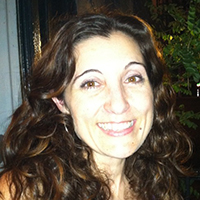 Beatriz Lado is an Assistant Professor at Lehman College (CUNY), where she directs the Linguistics Program and teaches Spanish, including Spanish for native speakers, and linguistics courses. She also teaches SLA courses in CUNY’s Graduate Center and has extensive experience directing language programs and training language teachers. Lado is interested in the interaction between pedagogical conditions and individual differences in bi/multilingual acquisition, and in bridging the gap between research and teaching. Her publications have appeared in journals such as Language Learning, Foreign Language Annals, and Language Teaching Research. Recently, she co-edited (with C. Sanz) Individual Differences, L2 Development, & Language Program Administration: From Theory to Practice (Boston, MA: Cengage Learning).
Beatriz Lado is an Assistant Professor at Lehman College (CUNY), where she directs the Linguistics Program and teaches Spanish, including Spanish for native speakers, and linguistics courses. She also teaches SLA courses in CUNY’s Graduate Center and has extensive experience directing language programs and training language teachers. Lado is interested in the interaction between pedagogical conditions and individual differences in bi/multilingual acquisition, and in bridging the gap between research and teaching. Her publications have appeared in journals such as Language Learning, Foreign Language Annals, and Language Teaching Research. Recently, she co-edited (with C. Sanz) Individual Differences, L2 Development, & Language Program Administration: From Theory to Practice (Boston, MA: Cengage Learning).
Teaching Italian to Spanish Speakers: Theory and Practice in the Classroom
Brief Description
According to data gathered in 2010, there are over 66,000 Hispanic students enrolled at CUNY. Enrollment for this group has increased by approximately 28% in the last two years. Most of these students speak Spanish as their native or heritage language and many of them take classes in Italian, French, or Portuguese, languages which they perceive to be easier to acquire than others due to their similarities with Spanish. This project aims at developing teaching strategies, methodologies, and concrete pedagogical material specifically targeted to Spanish heritage-speakers learning what is probably the closest to Spanish amongst all the Romance languages, although less commonly taught than the others: Italian. When this material is created, it will allow students to progress faster through the language levels, creating tracks that will be particularly attractive to Spanish-speaking learners, which might result in a higher number of students enrolling in Italian classes. For the experimental part, I will create and implement an assessment tool to measure and evaluate the passive competence of Italian on the part of students who have no previous knowledge of this language, but are heritage speakers of Spanish. For the practical part, I will work on the creation of a special curriculum for Spanish-speaking learners of Italian who have no previous knowledge of this language (level A1). I will also produce a set of activities tailored to the level A1 of Spanish-speakers that will constitute a repertoire of pedagogical material available to all the instructors of Italian across CUNY. Finally, once the project is completed, I plan to organize specific workshops on teaching Italian to Spanish-speaking students, in order to train other faculty members who work with a student population with a similar linguistic profile.
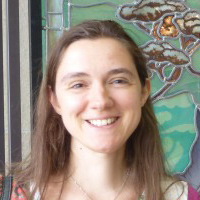 Elena Borelli is Assistant Professor of Italian at Bronx Community College, CUNY. She received her Ph.D. in Italian Literature from Rutgers University, and she also holds a Master’s degree in Language Acquisition from the university of Venice Ca’ Foscari, Italy. Her research focuses on the Italian literature of the fin de siècle, with a focus on nationalism and intellectual history. She has recently edited a collection of essays devoted to the theme of desire in modern and contemporary Italian literature, which is in print with Cambridge Scholars Publishers. She has also an interest in second language acquisition, and in particular the teaching of Italian to Anglophone learners.
Elena Borelli is Assistant Professor of Italian at Bronx Community College, CUNY. She received her Ph.D. in Italian Literature from Rutgers University, and she also holds a Master’s degree in Language Acquisition from the university of Venice Ca’ Foscari, Italy. Her research focuses on the Italian literature of the fin de siècle, with a focus on nationalism and intellectual history. She has recently edited a collection of essays devoted to the theme of desire in modern and contemporary Italian literature, which is in print with Cambridge Scholars Publishers. She has also an interest in second language acquisition, and in particular the teaching of Italian to Anglophone learners.
Advantage or Disadvantage: Exploring the Linguistic Challenges of Brazilian Portuguese Language Acquisitions with Spanish Speakers
Brief Description
As Brazil’s global position as an emerging power solidifies, the demand in diverse sectors for Portuguese speakers continues to expand. Since Bronx Community College introduced Portuguese language study in 2008, several pedagogical challenges have arisen in the classroom. Curiously, almost all students that enroll in our Portuguese classes are native or heritage-Spanish speakers. It is common for many Spanish speakers to perceive the learning of Portuguese to be an easy task due to the assumed similarities in the two languages. However, Spanish fluency does not necessarily provide an advantage in the acquisition of Portuguese. The main objective of this study is to highlight, and better understand, the bi-directional language advantages and interferences posed during the language acquisition process. That Portuguese is remarkably similar to Spanish presents a unique set of advantages and challenges to students and instructors alike. This study will focus on Brazilian Portuguese, which remains the most studied dialect in the United States and the Americas, and provide an awareness of these differences, which often surprise Spanish speakers learning Portuguese, who are misled by the idea of two very similar languages. One factor, for instance, can be attributed to the difference in the number of vowels of the two languages. For many centuries, Spanish has been characterized by system of five stable vowels, whereas Portuguese has a system of twelve unstable vowels, namely vowels that change in quality. Changes in vowel quality permeate spoken Portuguese and this instability has characterized the language throughout its evolution. This project will present an overview of the subject, a summary of specific areas of grammar that can be particularly troublesome to heritage speakers of Spanish, and a review of the pedagogical challenges faced in the classroom. It will examine the considerations for those teaching Brazilian Portuguese to Spanish speakers and look at grammatical and phonetic differences between the two languages, particularly those that are identified as the area learners experience the most confusion. It will also offer theories, techniques, recommendations, and data to help identify how to maximize positive transfer of language acquisition, and minimize negative transfer of Spanish in the acquisition of Brazilian Portuguese.
 Alexander Lamazares is Associate Professor of Spanish & Portuguese, Portuguese Language Coordinator, and Deputy Chair of the Department of Modern Languages at Bronx Community College. He received his M.A. from the University of Chicago, and his doctorate from the University at Albany, SUNY. He is a recipient of a National Endowment for Humanities fellowship, which was based in Brazil. His current research looks at contemporary Brazilian visual culture, with a focus on São Paulo as an urban space of modernity. He is also interested in second language acquisition, with a focus on Portuguese instruction to Spanish heritage speakers.
Alexander Lamazares is Associate Professor of Spanish & Portuguese, Portuguese Language Coordinator, and Deputy Chair of the Department of Modern Languages at Bronx Community College. He received his M.A. from the University of Chicago, and his doctorate from the University at Albany, SUNY. He is a recipient of a National Endowment for Humanities fellowship, which was based in Brazil. His current research looks at contemporary Brazilian visual culture, with a focus on São Paulo as an urban space of modernity. He is also interested in second language acquisition, with a focus on Portuguese instruction to Spanish heritage speakers.
The Learning and Teaching of Spanish as a Heritage Language in New York City
Brief Description
In the last few decades, research on foreign language teaching and learning has focused on the specific needs of heritage language (HL) speakers in the United States. Whilst some have asserted that well-implemented differentiation strategies may be enough to support these learners and provide them with the opportunity to improve their language skills in a “traditional” FL classroom, others have called for the creation of language classes exclusively designed for the HL population. The proposed study responds to the need to continue improving HL teaching and learning in our respective institutions. Specifically, one of the main goals of the project is to enhance the study of Spanish as a HL at CSI. Despite having a large Hispanic and Spanish-speaking population, CSI’s Spanish for heritage speakers sequence of courses has been dormant for quite some time. Students are usually placed in courses designed for non-native speakers of the language, which leads to a number of challenges. Moreover, given the usual time and curricular constraints, it is very difficult for instructors to really tap into these students’ language abilities. It is our hope that, by rethinking how these courses geared towards heritage Spanish speakers are designed and by making the learning process more pertinent and meaningful for these learners, the process of learning (or relearning) their HL will lead to more successful linguistic gains. The second goal of the proposed project is to better prepare future teachers of Spanish at CSI and CCNY to work with heritage populations in public schools, community centers, and non-profit organizations. The central focus of the project will be to infuse Community Service-Learning (CSL) into the Spanish for heritage speakers courses at CSI and into the Secondary Spanish Education programs at CSI and CCNY. CSL, as defined by Barbara Jacoby, is “a form of experiential education that engages students in activities that address human and community needs together with structured opportunities intentionally designed to promote student learning and development.” This type of hands-on pedagogy provides students the opportunity to reflect on their involvement in their service, facilitating a deeper understanding academic content and community awareness.
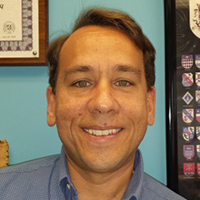 Edwin A. Lamboy (B.A. – University of Puerto Rico at Río Piedras, M.Ed. – Lehman College, Ph.D. – Penn State University) is the Secondary Spanish Education Program Director and Chair of the Secondary Education Department at the City College of New York, where he teaches education and Spanish linguistics courses. Dr. Lamboy has published several articles on Caribbean Spanish and the teaching of Spanish to heritage speakers, and has published three books: Caribbean Spanish in the Metropolis (Routledge, 2004), Temas (Thomson Learning, 2006), and Spanish in Bilingual and Multilingual Settings around the World (Brill, 2012).
Edwin A. Lamboy (B.A. – University of Puerto Rico at Río Piedras, M.Ed. – Lehman College, Ph.D. – Penn State University) is the Secondary Spanish Education Program Director and Chair of the Secondary Education Department at the City College of New York, where he teaches education and Spanish linguistics courses. Dr. Lamboy has published several articles on Caribbean Spanish and the teaching of Spanish to heritage speakers, and has published three books: Caribbean Spanish in the Metropolis (Routledge, 2004), Temas (Thomson Learning, 2006), and Spanish in Bilingual and Multilingual Settings around the World (Brill, 2012).
 Francisco Salgado-Robles (B.A., English Philology, Universidad de Sevilla; M.A.T, TEFL, Universidad de Extremadura; M.Ed., Bilingual Education, Universidad Pablo de Olavide; M.A., Spanish Applied Linguistics, University of Missouri; Ph.D., Hispanic Linguistics, University of Florida) is an Assistant Professor of Spanish and Linguistics in the Department of World Languages and Literatures at the College of Staten Island – The City University of New York.
Francisco Salgado-Robles (B.A., English Philology, Universidad de Sevilla; M.A.T, TEFL, Universidad de Extremadura; M.Ed., Bilingual Education, Universidad Pablo de Olavide; M.A., Spanish Applied Linguistics, University of Missouri; Ph.D., Hispanic Linguistics, University of Florida) is an Assistant Professor of Spanish and Linguistics in the Department of World Languages and Literatures at the College of Staten Island – The City University of New York.
His research resides at the intersection of Second Language and Bilingual Acquisition, and Sociolinguistics. He primarily examines how second and heritage language learners develop ‘sociolinguistic competence’ in different learning environments (e.g., classroom, study abroad, and service learning environments), i.e., the sensitivity to the context where language is used, including the sensitivity to differences in local geographical dialect, the sensitivity to differences in register, or, among others, the sensitivity to speaking in a native-like or natural way. This allows him to evaluate relationships between study setting, language use, and language gains.
Dr. Salgado-Robles has presented his research at national and international conferences. His work has been published in several specialized journals, including Revista Interlingüística, Revista de Humanidades, Relingüística Aplicada, Revista de Estudios Hispánicos, Boletín de Filología de la Universidad de Chile, and Revista de Estudios de Lingüística Aplicada.
Engaging Understudied Languages through a Science-Core Linguistics Class
Brief Description
For many students, their first exposure to endangered languages and heritage languages comes through an introductory linguistics class. This experience is both intellectually enlightening and personally empowering. For example, students who speak creole languages may find their linguistic background marginalized in some disciplines, but in a linguistics class, it is treated as an asset—a repository of information about the human mind. We propose to implement a new design of the course Analyzing Language that incorporates endangered and understudied languages into the core of the curriculum and promotes student engagement through an original research project. The new course design offers students a unique opportunity to engage with a large number of languages; in-class activities, homework assignments, and exam problems feature languages from different families and geographical regions. The course culminates in a semester-long “Adopt-a-Language” fieldwork project, in which each student gathers and analyzes data from a language of his or her choice. Students will publish their research findings in a shared class database hosted by Blackboard’s wiki tool. Analyzing Language fulfills the Pathways Scientific World Core requirement, so students in a variety of majors will have access to the course. This project, the redesign of the curriculum, and implementation of a new fieldwork component will increase student mastery of the core scientific and linguistic concepts of the course; it will also foster student engagement with the global language endangerment crisis and support retention efforts for speakers of understudied languages by treating their linguistic expertise as an academic resource.
 Ignacio Montoya is a Ph.D. student in the Linguistics Program at the Graduate Center. His academic interests include phonology and morphology, cognitive approaches to syntax and semantics, and historical linguistics; his work has involved research in Romance and Semitic languages. In addition to the linguistics courses he has taught, Ignacio has served as the MAGNET coordinator of the CUNY Pipeline Program, which supports underrepresented undergraduates who are interested in graduate school. Prior to starting his doctoral work, he taught elementary and middle school in New York and Los Angeles.
Ignacio Montoya is a Ph.D. student in the Linguistics Program at the Graduate Center. His academic interests include phonology and morphology, cognitive approaches to syntax and semantics, and historical linguistics; his work has involved research in Romance and Semitic languages. In addition to the linguistics courses he has taught, Ignacio has served as the MAGNET coordinator of the CUNY Pipeline Program, which supports underrepresented undergraduates who are interested in graduate school. Prior to starting his doctoral work, he taught elementary and middle school in New York and Los Angeles.
 Teresa O’Neill is a PhD candidate in the Linguistics Program at the CUNY Graduate Center, and an adjunct lecturer at Queens College. Her research focuses on theoretical syntax; her dissertation project examines the structure of different types of clauses that lack lexical (content) verbs, in order to discover the fundamental properties of the sentence. She is also interested in language revitalization and endangered language documentation. Teresa has extensive experience developing and teaching courses on a variety of topics in linguistics, including syntax, language typology, endangered and understudied languages, phonology, and sociolinguistics.
Teresa O’Neill is a PhD candidate in the Linguistics Program at the CUNY Graduate Center, and an adjunct lecturer at Queens College. Her research focuses on theoretical syntax; her dissertation project examines the structure of different types of clauses that lack lexical (content) verbs, in order to discover the fundamental properties of the sentence. She is also interested in language revitalization and endangered language documentation. Teresa has extensive experience developing and teaching courses on a variety of topics in linguistics, including syntax, language typology, endangered and understudied languages, phonology, and sociolinguistics.



